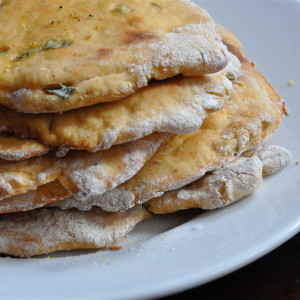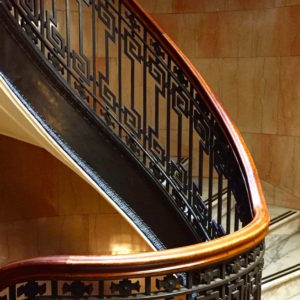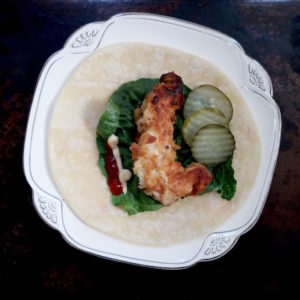Fast Flatbread
I can’t tell you how often I’ve searched my cookbooks for the ideal flatbread recipe. By ideal, I mean a recipe you can mix, roll, bake, and eat in under an hour. Further, this recipe must use pantry ingredients and have a low yield.

Why a low yield? We are a household of two people. Flatbreads keep for two minutes before hardening into projectiles. While it’s true that unbaked flatbreads may be frozen, we’ve all done this, and we’ve all found that sodden freezer-burned wedge of frozen dough, months or years later…and tossed it. And felt guilty.

Better to have a low yield.
This recipe may be assembled and baked–or cooked stovetop–without any resting time. Having said this, I rested doughs for twenty minutes, an hour, and overnight (this last in the fridge). The longer the rest, the better the resulting flatbread.

I don’t have a picture of resting dough. Instead, I give you the Golden Gate Bridge. Go ahead. Tell me a photo of flatbread dough would’ve been preferable.
Yeah. I thought so.

Here’s the other direction. So it’s…Marin Country? Richmond? Both? That general direction. Anyway, as you see, it was a lovely day at the Berkeley Marina. If you ever wonder why people pay insane amounts of money to live in the San Francisco Bay Area, well, this is less than two miles from the IK’s house, is wheelchair accessible, and offers ample free parking. I took this last Sunday. Which means it was February. We needed light jackets.
Returning to flatbread. You can bake or griddle these breads. My oven has five burners, one covered with a heavy iron plate:

There’s a large gas burner underneath that plate, making it a fine place to bake flatbreads. You can also use a cast iron frying pan of any size.
Oven baking produced breads that puffed prettily.

Finally, these breads may be baked using all-purpose flour or a mixture of wheat and all-purpose flour, which John and I agreed gave the best result. I added a single minced scallion and some sea salt, but all manner of fresh herbs and spices may be added. Or leave it plain.

Fast Flatbread
Inspiration for this recipe came from Yotam Ottolenghi’s Plenty and the first edition of Deborah Madison’s Vegetarian For Everyone
As always, * denotes resting spots.
Yield: 6-8 flatbreads
prep time: About 10 minutes; the dough may be baked immediately, or rested 20 minutes to overnight. You may also form the flatbreads, wrap them airtight, freeze them, and then bake them directly from frozen. Baking time is 4-5 minutes per flatbread; if baking from frozen it will take a little longer.
Equipment: large bowl, small rolling pin, sharp knife, or bench knife. To bake the breads: either a cast iron pan, flat stovetop grill surface, or oven with heavy baking sheets or baking stone.
1 cup/226g all purpose flour (see notes)
2/3 cup/5 ounces/140 g full fat plain yogurt
1 teaspoon baking powder
1/2 teaspoon salt
Additional sea salt, to taste
optional additions:
one minced scallion
minced garlic
fresh herbs like thyme, cilantro, basil
spices like ground cumin, coriander, or a little cayenne-about 2 teaspoons
Additional flour, for the kneading surface
Possibly a little water; you may not need it
If you plan to bake immediately, preheat the oven to 475/gas mark 9/245C. Place a baking stone or heavy baking sheet to preheat.
If using a cast iron pan or stovetop hot plate, preheat it to high. For a pan, slip a pot holder over the pan handle to avoid being burned.
*
In a large mixing bowl , mix the flour(s), yogurt, baking powder, salt, and any additional spices or seasonings. Use clean hands or a wooden spoon.
Flour a clean counter lightly. Tip the flatbread mixture out and knead into a ball.
Bread making is an inexact art. The dough may need more water or flour. This depends on the weather, your kitchen, and your flour. You want the dough to be firm and pliable; it should neither be so wet nor so dry that it cannot cohere. Nor should it be so sticky that it sticks to your counter or hands. Trust your instincts.
You can now place the dough in the washed bowl, cover it with plastic wrap, and rest it at room temperature for up to an hour. Or refrigerate up to 24 hours. Bring dough to room temperature before baking.
*
Or immediately roll out and bake the flatbreads:
Scatter more flour on counter if needed. Cut dough into six to eight equally sized pieces. Roll each piece into an oval-shaped, thin bread; these need not be perfectly shaped. Scatter a bit of flour if dough sticks to pin or counter, but not to overdo it. Shake excess flour off breads. Lay on baking surface. Bake about two minutes each side, flipping with tongs until nicely speckled with brown. Remove to a plate or platter.
Covering the breads with a clean, dampened dishtowel keeps the breads soft and flexible. You can leave them this way for a good 4-5 hours after baking.
Any leftover breads may be bagged or wrapped well, refrigerated, and reheated the next day. After that they stale, and the best you can do is break them up and use for croutons or in soups.
Unbaked breads may be wrapped airtight and frozen. To bake from frozen, place directly in preheated oven. They take longer to bake than fresh, and will not puff up, but will still be good.
Notes:
Substitute up to 1/4 cup/2 ounces/56 g of whole wheat flour for the all purpose flour.
In lieu of a fancy baking stone, I use plain clay kitchen tiles, bought cheaply at the local hardware store. Be sure the tiles have no glues or adhesives on the undersides.





